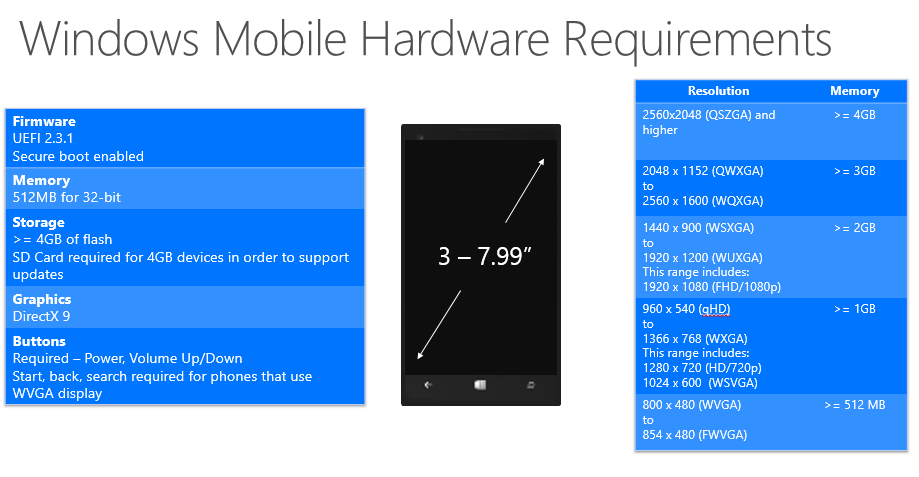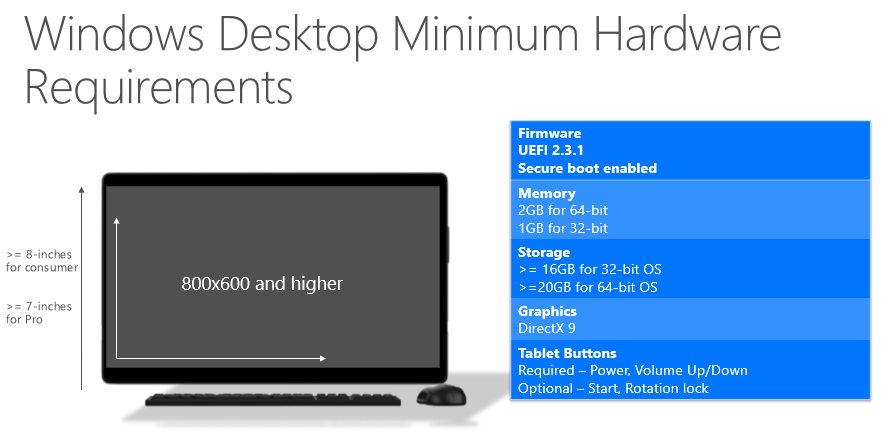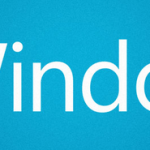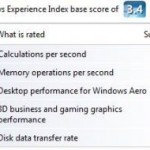The information on Windows 10 system requirements were revealed during the “Minimum System HW Requirements & Compatibility for Windows Platforms” event during WinHEC Shenzhen 2015, which was intended for OEMs, ODMs and IDHs who design devices of various form factors from small, lost cost devices to high end gaming PCs. The slide detailed the Windows 10 system requirements was posted online, offering insights into hardware specifications required by Windows 10.
Windows 10 has a unified core but different releases for different kind of devices, such as computer, tablet and phone. Thus, the minimum hardware requirements very much depends on where you plan to run Windows 10. Do also note that if you’re only intending to upgrade your current Windows 7, Windows 8, Windows 8.1 or older systems to Windows 10, you probably can ignore requirements on optional hardware components such as sensors and etc.
Windows 10 for Mobile Minimum Hardware Requirements
The version of Windows 10 for mobile devices such as smartphones (i.e. Windows Phone and apparently Android) and tablets requires a minimum:
- Screen size between 3 to 7.99 inches.
- Firmware supporting UEFI 2.3.1 with Secure Boot enabled.
- 512 MB of memory, and more for higher resolution as shown in table below:
Resolution Memory 2560×2048 (QSZGA) and higher >= 4GB 2048×1152 (QWXGA) to 2560×1600 (WQXGA) >= 3GB 1440×900 (WSXGA) to 1920×1200 (WUXGA) – including 1920×1080 (FHD/1080p) >= 2GB 960×540 (qHD) to 1366×768 (WXGA) – including 1280×720 (HD/720p) & 1024×600 (WSVGA) >= 1GB 800×480 (WVGA) to 854×480 (FWVGA) >= 512MB - More than 4GB of flash storage space (at the bare minimum of 4GB disk space, a SD card is required to support updates).
- Graphics card supporting DirectX 9.
- Power, Volume Up, Volume Down buttons, and Start, Back, Search buttons for phones with WVGA display.
- Trusted Platform Module (TPM) enabled.
If the Windows 10 is installed on a smartphone, of course, some standard components that one would expect on the phone is required, such as cellular radio, speaker, earpieces, headphone or headset jack connector, 802.11b/g wireless, 2-finger multitouch with HID-compliant, vibration mechanism for notification, various sensors such as accelerometer, magnetometer, ALS, proximity, gyroscope and etc is required. Depending of the form factors, some of these components are optional.
Windows 10 for Desktop Minimum Hardware Requirements
Anything with screen size equal to or more than 8 inches for consumer devices, or equal to or more than 7 inches for businesses using Windows 10 Pro have to run Windows 10 for desktop version, which includes most desktops, notebook computers, tablets and hybrid PCs. The desktop version requires:
- Processor: 1 gigahertz (GHz) or faster processor or SoC
- Firmware supporting UEFI 2.3.1 with Secure Boot enabled.
- RAM: 2GB memory for 64-bit Windows 10 and 1GB memory for 32-bit Windows 10.
- Hard disk space: 16 GB for 32-bit OS 20 GB for 64-bit OS
- Display: 1024×600 at minimum screen resolution of 800 x 600 pixels.
- Graphics card supporting DirectX 9 or later with WDDM 1.0 driver.
- Tablet and hybrid devices must have Power, Volume Up and Volume Down buttons.
- Trusted Platform Module (TPM) 2.0 enabled 1 year after RTM, optional before that.
Unlike Windows Mobile 10, Windows Desktop 10 doesn’t have many requirements on other components and sensors. Those are optional and is good to have though.
One obvious missing item in the system requirements of Windows 10 is CPU microprocessor. Welcome to the world of good enough computing, where most modern CPU will run any operating system and software application thrown at it finely. And Windows 10 does add new SoC processors support as listed below, which means even more devices can run or flash to Windows 10, even though it comes with other OS such as Android.
- Qualcomm MSM8909
- Qualcomm MSM8208
- Qualcomm MSM8994
- Qualcomm MSM8992
- Qualcomm MSM8952
- Intel Cherry Trail
- Intel Skylake
- Intel Atom x3 (LTE)
- AMD Carrizo
- AMD Carrizo-L
In addition, specific requirements may also applies to certain features. For more info, check out http://www.microsoft.com/en-US/windows/windows-10-specifications.
Windows 10 is expected to be launched in summer 2015.
- Windows 10 20H2 v.2009 (Build 19042)
- Windows 10 May 2020 Update v.2004 (Build 19041)
- Windows 10 November 2019 Update v.1909 (Build 18363)
- Windows 10 May 2019 Update v.1903 (Build 18362)
- Windows 10 October 2018 Update v.1809 (Build 17763)
- Windows 10 Spring Creators Update v.1803 (Build 17134)
- Windows 10 Fall Creators Update v.1709 (Build 16299)
- Windows 10 Creators Update v.1703 (Build 15063)
- Windows 10 Anniversary Update v.1607 (Build 14393)
- Windows 10 November 2015 Update v.1511 (Build 10586) | Download Windows 10 Version 1511 (Build 10586) ISO
- Download Official Windows 10 ISO | Upgrade to Windows 10
- Windows Insiders get free Windows 10 genuine license
- Windows 10 Upgrade is free for Windows 8.1 and Windows 7 systems until July 29th, 2016 (Reserve Windows 10 upgrade or Lock in the free Windows 10 Upgrade License)
- Trick to upgrade to Windows 10 for free after free upgrade offer perioed ended.
- Clean install and activate Windows 10 is allowed (No Windows 10 product key is issued for Windows 10 upgrade license acquired under the free upgrade program. However, Microsoft records the device’s hardware ID or HWID on its activation server when the device is first upgraded to Windows 10 and activated. On future reinstallation of Windows 10, the device will automatically be granted permanent activation status when the activation server detects its matching hardware ID).
- Windows 10 general avaiability release date is on July 29th, 2015
- Windows 10 Features
- Windows 10 editions (SKUs)
- Windows 10 editions features comparison chart
- Windows 10 upgrade path (upgrade matrix)
- Windows 10 system requirements
- Windows 10 Prices: Retail Licenses | OEM Licenses






